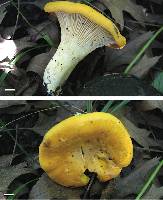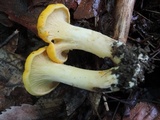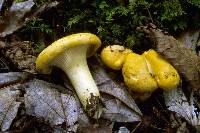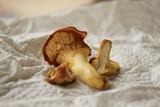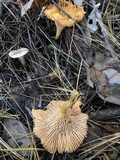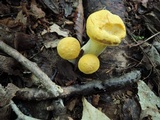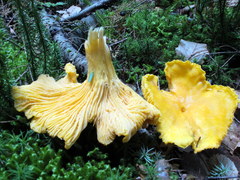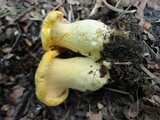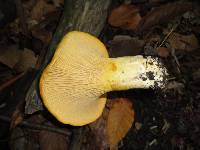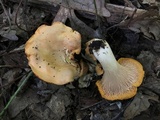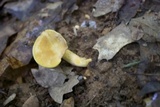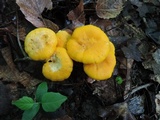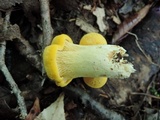
|
|
|
|
Family: Cantharellaceae
|
Foltz MJ, Perez KE, Volk TJ. 2013. Molecular phylogeny and morphology reveal three new species of Cantharellus within 20 m of one another in western Wisconsin, USA. Mycologia 105: 447-461. Cantharellus phasmatis M.J. Foltz & T.J.Volk, sp. nov. Fig. 1A, B, SUPPLEMENTARY FIGS. 1–3 MycoBank MB800425, C0171588F. Pileus yellow; hymenium pale cream to white, becoming pink; stalk pale yellowish white, becoming yellow; tissues staining ochraceous brown when bruised; spore print pink. Molecular data from ITS and TEF1 loci distinguish this species from all other Cantharellus species (Figs. 4, 5). Etymology: Named phasmatis meaning “ghostly” for the distinctive ghostly white hymenium of young specimens of this chanterelle. Holotypus: UNITED STATES. WISCONSIN: La Crosse County, Hixon Forest Park, along the path running parallel to Bliss Road, associated with oak in oak-hickory mixed deciduous forest. N43.8157° W91.2091°, 18-VII-2010, here designated Foltz C073, Collection CP002, C0171588F. Pileus egg-yolk yellow or paler (especially in sunlight or dry conditions), 6–12 cm diam, planoconvex, becoming broadly convex to depressed, often mottled at maturity, partly due to spore deposit, surface dry and covered in a thin layer of fibrils, staining ochraceous brown when bruised; margin incurved when young, regular to irregular, sometimes lobed, often wavy with age, context thick, white, firm; lamellae deeply decurrent, white when young, becoming pinkish buff with age, often yellowish near the margin, often forking and anastomosing, sometimes almost poroid in some specimens near the margin, bruising ochraceous brown; stipe white and solid, yellowing and peeling with maturity, bruising ochraceous brown, 4–8 cm long, 1–3 cm thick, context white; spore deposit salmon-pink, (7)7.5–10(11) × 4–6(7) μm, subglobose to ovate when immature, mature spores are obovate to oblong, sometimes reniform (n = 30); basidia (55)60–70(75) × (7)7.5–11(13) μm, 4–6 sterigmate, clavate, often undulate; pileus hyphae with long terminal cells, 95–105 × 4.5–5.5 μm, sometimes with thickened walls; clamps found in all tissues; odor strong and pleasant, like apricots; flavor mild at first, becoming peppery; KOH intensifying color of all tissues. Habitat, habit and distribution: gregarious to scattered; associated with Quercus (Fagaceae) and Carya (Juglandaceae) (oak-hickory); often found growing in lines along roots; common Jul–Aug in La Crosse, Wisconsin, presumably more widespread. Edibility: choice; these are the most delectable chanterelles we have eaten. Additional specimens examined: UNITED STATES. WISCONSIN: La Crosse County, Hixon Forest Park, along the path parallel to Bliss Road, associated with Quercus (oak) in oak-hickory mixed deciduous forest. 18-VII-2010,CP001, CP002, CP003. Comments: This species can be distinguished from other chanterelles by its white hymenium that becomes pink with age, and by its pink spore print. This species is probably the same as C. cibarius var. pallidifolius described by Smith in 1968 (see DISCUSSION). We suggest the common name “ghost chanterelle” for this species. |











